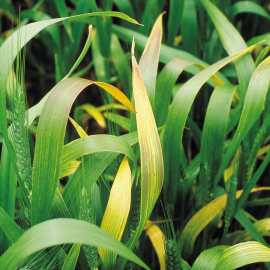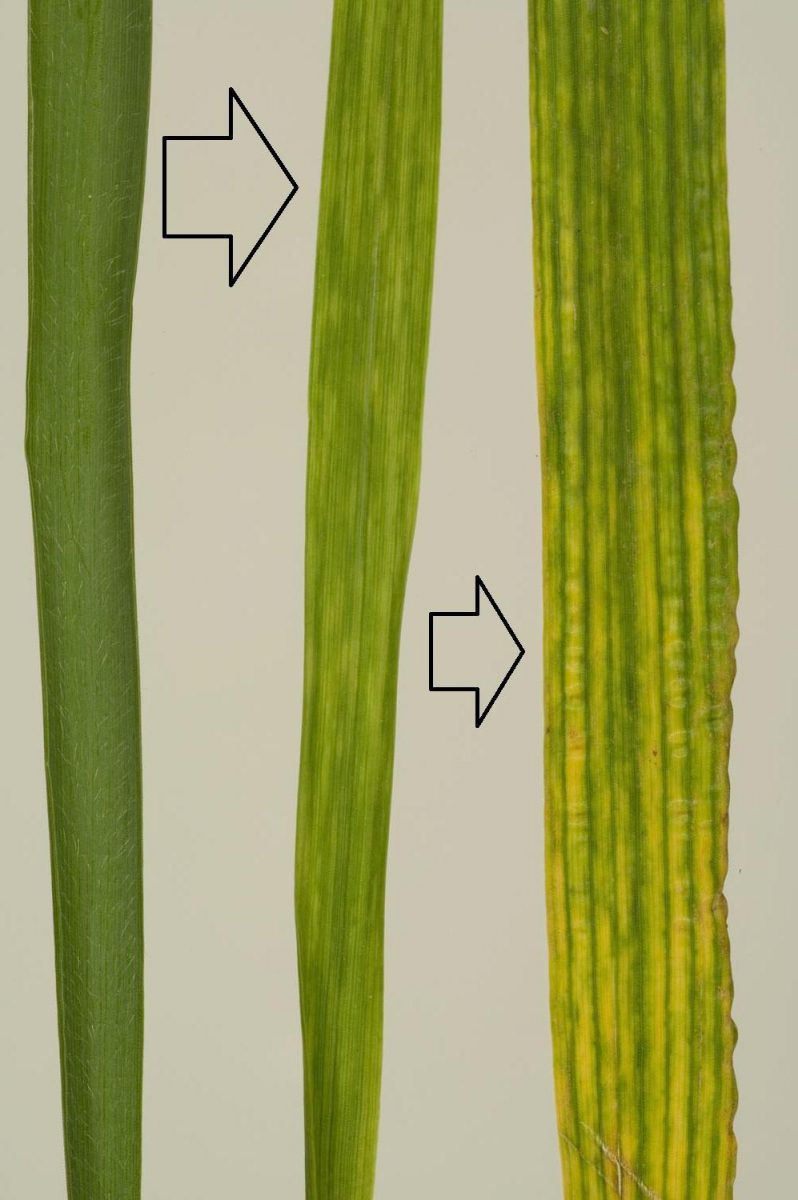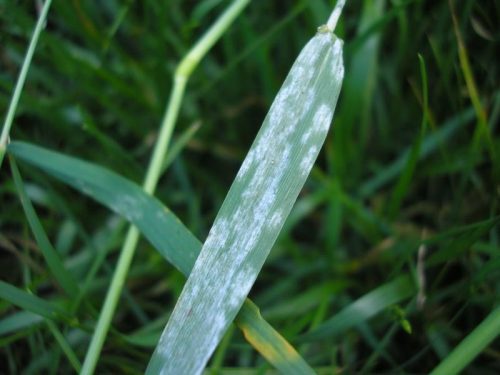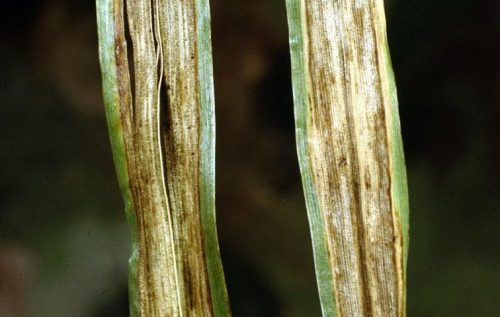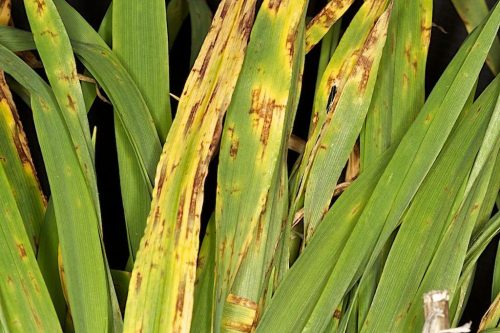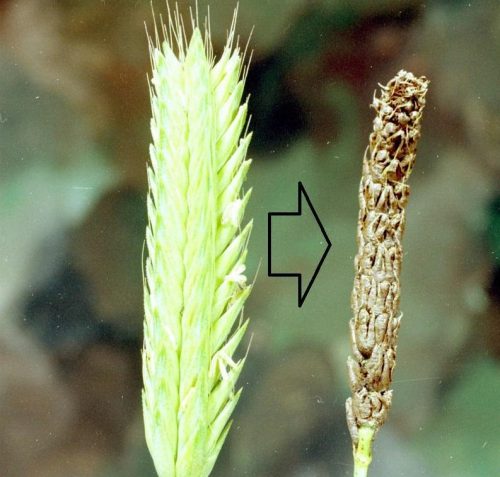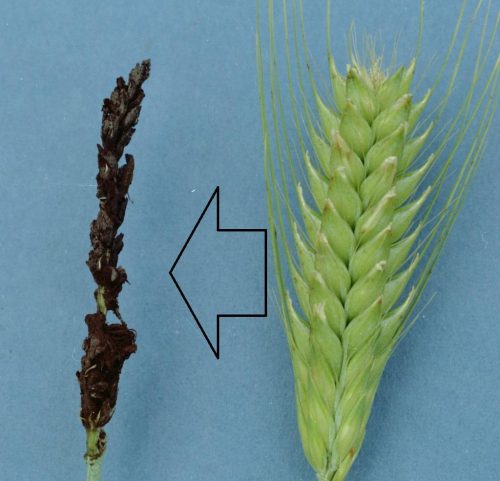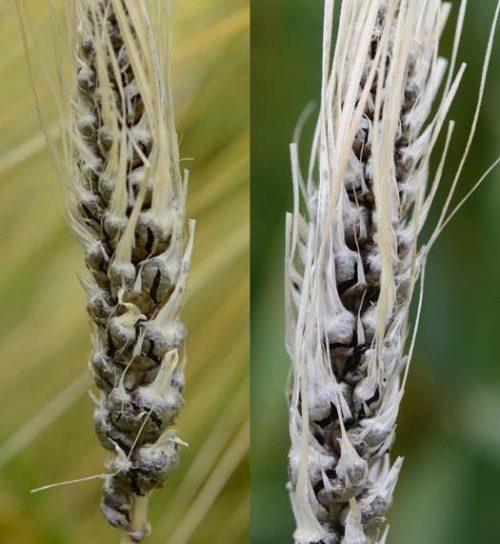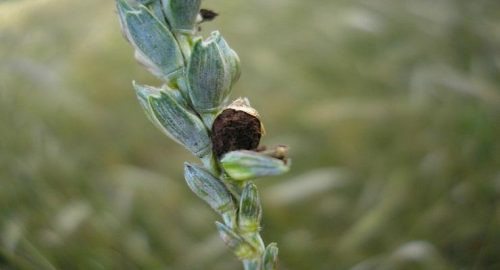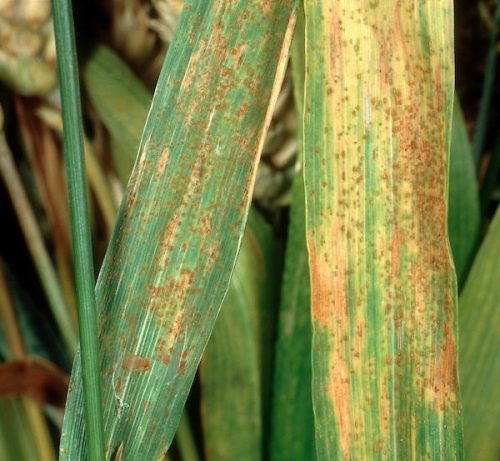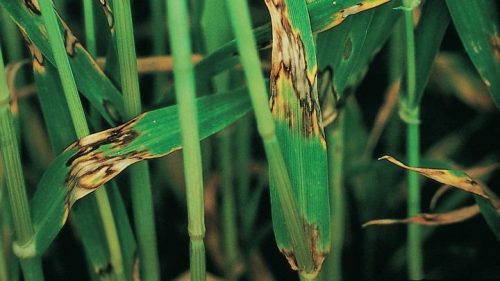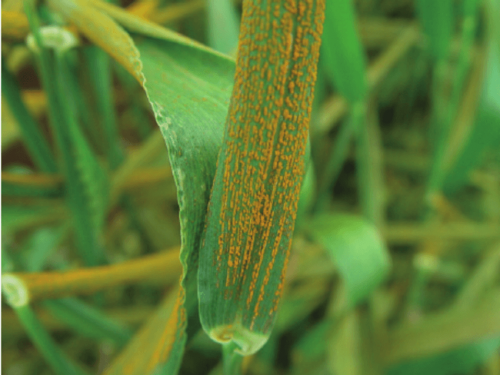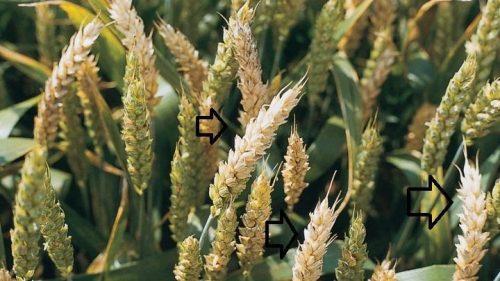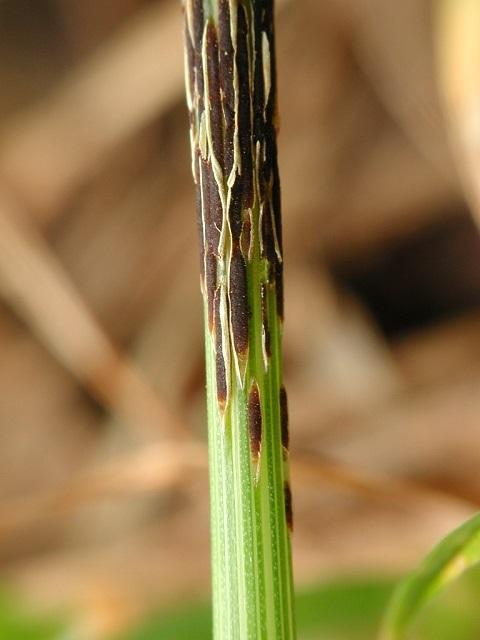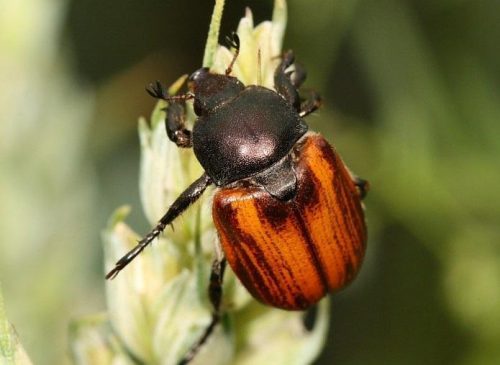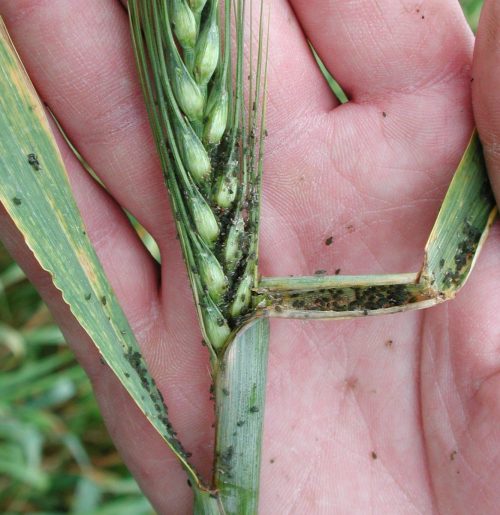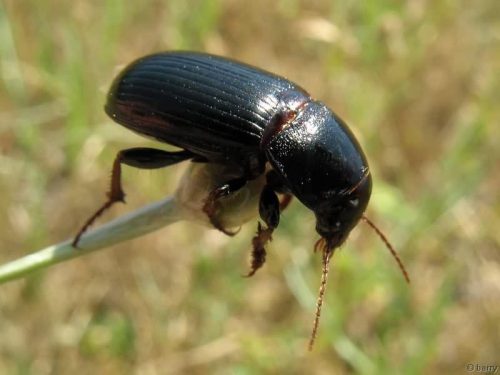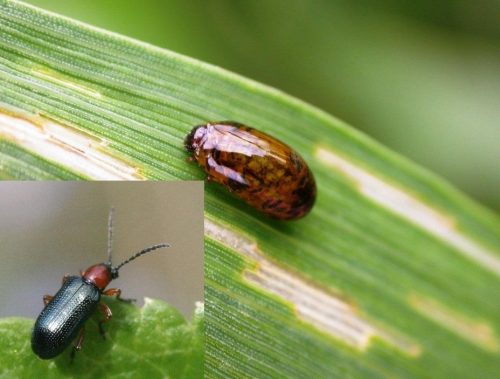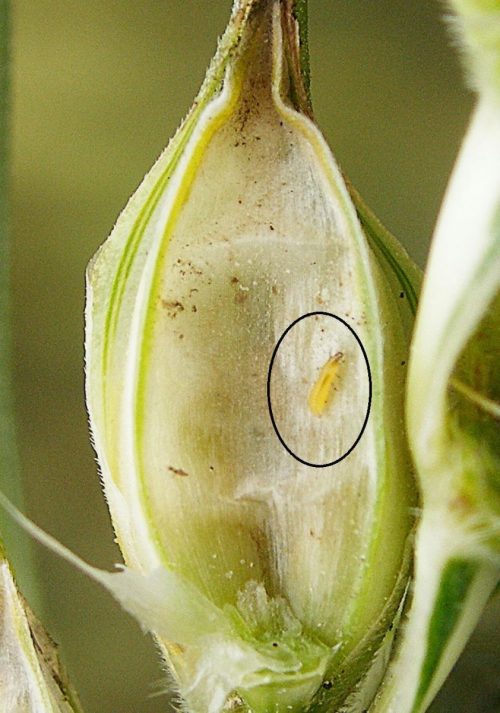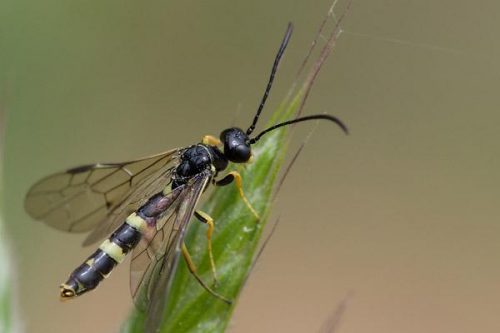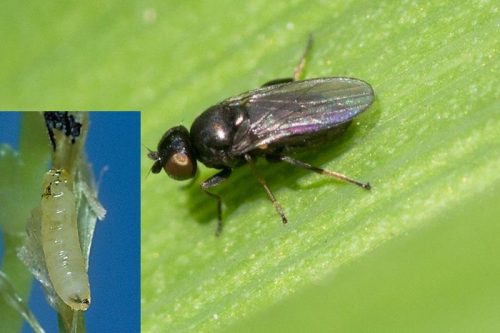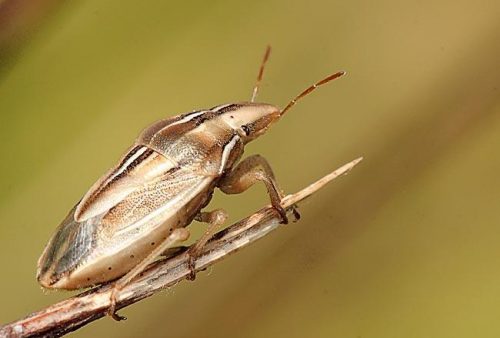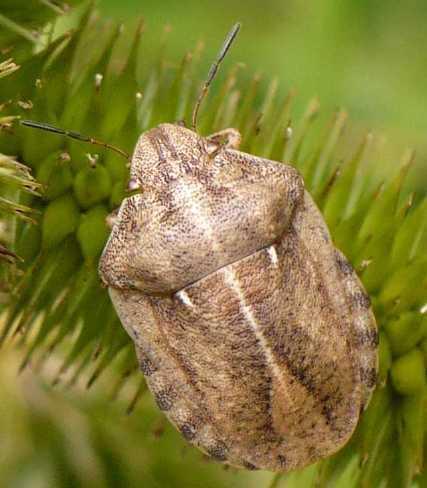Barley treatments, pest and disease control
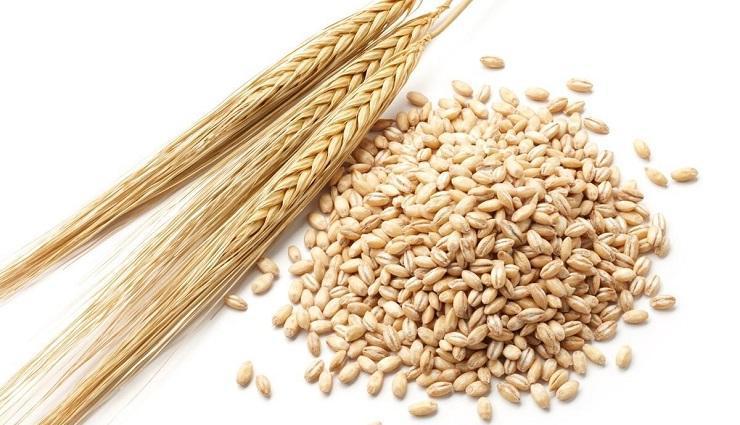
Barley (Hordeum vulgare) is one of the first plants introduced into the culture, being cultivated since the Stone Age, with the beginnings of agriculture. Currently, barley cultivation is widespread from the equatorial area to the Arctic region. This plant is greatly used, both in human nutrition and in animal feed. It is also used in brewing. Barley contains large amounts of manganese, selenium, phosphorus, copper, magnesium, iron, zinc, and potassium and is an important source of fiber. Barley is similar to wheat and for this reason, they “share” a number of diseases and pests.
The main diseases of barley
Barley yellow dwarf virus
The attacked plants have a darker color and then turn yellow. The virus attacks the plants even in the seedling phase, dwarfing them. This is accompanied by the fact that the spikes no longer develop. If the plants are affected in the tillering phase, they germinate less, and the tips and ribs of the leaves become yellow. The attacked plants develop spikes, but with a large number of sterile spikelets. This virus is transmitted by aphids.
Prevention and control measures:
- destroying the weeds in the crop;
- carrying out specific field works;
- sowing at the optimum time;
- applying insecticides to control aphids;
- cultivating resistant varieties.
Barley stripe mosaic virus
The infected barley seeds result in seedlings that are slightly yellow. Then, the virus evolves, the leaves presenting yellow or gray stripes alternating with healthy areas. Thus, the plant acquires a mosaic appearance. During the spike development phase, the spots on the leaves turn brown and the attacked tissues die. The attacked plants develop small, sterile spikes. This virus is transmitted through infected seeds.
Prevention and control measures:
- destroying the weeds (from the Poaceae family) from barley crops;
- carrying out specific agrotechnical works;
- cultivating resistant varieties;
- using certified seeds, from a reliable source;
Powdery mildew (Erysiphe graminis)
The disease appears in spring. On the basal leaves and stems develop white, felt-like spots. The spots become dusty, and on them appear circular formations that represent the fructification of the fungus. The attack can spread quickly and can even attack the spikes. The attacked tissues turn yellow and dry out. The leaves dry out prematurely, the spikes do not grow normally, and the plant produces dry grains. The fungus overwinters on the plant remains from the surface of the soil. Wet autumn weather can cause autumn infections. The occurrence of the disease is favored by excessive fertilization with nitrogen, monoculture, or high density when sowing.
Prevention and control measures:
- burying plant remains through plowing;
- destroying the weeds;
- balanced fertilization;
- cultivating resistant varieties;
- carrying out 1-2 treatments with specific fungicides in the phenophase of straw or spike development.
Recommended products
-
You can find products on a different store
Change Store -
You can find products on a different store
Change Store -
You can find products on a different store
Change Store -
You can find products on a different store
Change Store -
You can find products on a different store
Change Store -
You can find products on a different store
Change Store -
You can find products on a different store
Change Store -
You can find products on a different store
Change Store -
You can find products on a different store
Change Store -
You can find products on a different store
Change Store -
You can find products on a different store
Change Store -
You can find products on a different store
Change Store -
You can find products on a different store
Change Store -
You can find products on a different store
Change Store -
You can find products on a different store
Change Store -
You can find products on a different store
Change Store -
You can find products on a different store
Change Store -
You can find products on a different store
Change Store -
You can find products on a different store
Change Store -
You can find products on a different store
Change Store -
You can find products on a different store
Change Store -
You can find products on a different store
Change Store -
You can find products on a different store
Change Store -
You can find products on a different store
Change Store
Barley stripe (Pyrenophora graminea)
The first symptoms can be seen starting in April. On the foliar limb appear chlorotic stripes parallel to the main rib. Gradually, the spots turn brown, and the attacked tissues dry out and are covered with a gray fuzz. On this fuzz appear black-brown circular formations that represent the fructification of the fungus. The dry tissues break from the top to the base, and the leaves acquire a torn appearance. The attacked plants are poorly developed, the spikes are deformed, and form thin, hard, and browned grains. The disease is transmitted through infected barley seeds and the plant remains from the surface of the soil.
Prevention and control measures:
- keeping the optimum density;
- destroying the weeds;
- a correct crop rotation;
- balanced fertilization;
- using certified seeds, from reliable sources;
- carrying out treatments with specific fungicides.
Recommended products
-
You can find products on a different store
Change Store -
You can find products on a different store
Change Store -
You can find products on a different store
Change Store -
You can find products on a different store
Change Store -
You can find products on a different store
Change Store -
You can find products on a different store
Change Store -
You can find products on a different store
Change Store -
You can find products on a different store
Change Store -
You can find products on a different store
Change Store -
You can find products on a different store
Change Store -
You can find products on a different store
Change Store -
You can find products on a different store
Change Store -
You can find products on a different store
Change Store -
You can find products on a different store
Change Store -
You can find products on a different store
Change Store -
You can find products on a different store
Change Store -
You can find products on a different store
Change Store -
You can find products on a different store
Change Store -
You can find products on a different store
Change Store -
You can find products on a different store
Change Store -
You can find products on a different store
Change Store -
You can find products on a different store
Change Store -
You can find products on a different store
Change Store -
You can find products on a different store
Change Store
Net blotch (Pyrenophora teres)
The characteristic symptoms of this disease are manifested on the leaves. Small, yellow spots appear on them. The disease progresses and the spots become bigger. Brown stripes appear on the surface of the spots. They develop and the spots turn brown and become covered with a velvety fuzz. Following the attack, the leaves turn yellow and dry out. Under favorable conditions, the disease also attacks the spikes. These develop dry yellow-brown seeds that will transmit the infection in the next year. Also, the fungi can remain on the plant remains from the surface of the soil and cause infections in the following years.
Prevention and control measures:
- keeping the optimum density;
- destroying the weeds;
- a correct crop rotation;
- balanced fertilization;
- using certified seeds, from reliable sources;
- carrying out treatments with specific fungicides.
Recommended products
-
You can find products on a different store
Change Store -
You can find products on a different store
Change Store -
You can find products on a different store
Change Store -
You can find products on a different store
Change Store -
You can find products on a different store
Change Store -
You can find products on a different store
Change Store -
You can find products on a different store
Change Store -
You can find products on a different store
Change Store -
You can find products on a different store
Change Store -
You can find products on a different store
Change Store -
You can find products on a different store
Change Store -
You can find products on a different store
Change Store -
You can find products on a different store
Change Store -
You can find products on a different store
Change Store -
You can find products on a different store
Change Store -
You can find products on a different store
Change Store -
You can find products on a different store
Change Store -
You can find products on a different store
Change Store -
You can find products on a different store
Change Store -
You can find products on a different store
Change Store -
You can find products on a different store
Change Store -
You can find products on a different store
Change Store -
You can find products on a different store
Change Store -
You can find products on a different store
Change Store
Loose smut of barley (Ustilago nuda)
The attacked barley plants develop spikes prematurely. The components of the spike are destroyed and replaced by a black mass of spores. They are taken by the wind and reach other healthy plants or remain on the soil. Only the central stalk remains from the spike.
Prevention and control measures:
- cultivating resistant varieties;
- a correct crop rotation;
- treating the seeds before sowing.
Recommended products
-
You can find products on a different store
Change Store -
You can find products on a different store
Change Store -
You can find products on a different store
Change Store -
You can find products on a different store
Change Store -
You can find products on a different store
Change Store -
You can find products on a different store
Change Store -
You can find products on a different store
Change Store -
You can find products on a different store
Change Store -
You can find products on a different store
Change Store -
You can find products on a different store
Change Store -
You can find products on a different store
Change Store -
You can find products on a different store
Change Store -
You can find products on a different store
Change Store -
You can find products on a different store
Change Store -
You can find products on a different store
Change Store -
You can find products on a different store
Change Store -
You can find products on a different store
Change Store -
You can find products on a different store
Change Store -
You can find products on a different store
Change Store -
You can find products on a different store
Change Store -
You can find products on a different store
Change Store -
You can find products on a different store
Change Store -
You can find products on a different store
Change Store -
You can find products on a different store
Change Store
False loose smut (Ustilago nigra)
This disease is similar to the loose smut of barley. The components of the straw are destroyed and replaced by a black mass of spores. They are taken by the wind and reach other healthy plants or remain on the soil. The difference between these two diseases is that the loose smut of barley appears about 10 days later than the false loose smut.
Prevention and control measures:
- cultivating resistant varieties;
- a correct crop rotation;
- treating the seeds before sowing with fungicides.
Recommended products
-
You can find products on a different store
Change Store -
You can find products on a different store
Change Store -
You can find products on a different store
Change Store -
You can find products on a different store
Change Store -
You can find products on a different store
Change Store -
You can find products on a different store
Change Store -
You can find products on a different store
Change Store -
You can find products on a different store
Change Store -
You can find products on a different store
Change Store -
You can find products on a different store
Change Store -
You can find products on a different store
Change Store -
You can find products on a different store
Change Store -
You can find products on a different store
Change Store -
You can find products on a different store
Change Store -
You can find products on a different store
Change Store -
You can find products on a different store
Change Store -
You can find products on a different store
Change Store -
You can find products on a different store
Change Store -
You can find products on a different store
Change Store -
You can find products on a different store
Change Store -
You can find products on a different store
Change Store -
You can find products on a different store
Change Store -
You can find products on a different store
Change Store -
You can find products on a different store
Change Store
Covered smut of barley (Ustilago hordei)
The attacked barley plants develop spikes prematurely. The components of the spike are destroyed and replaced by the black mass of spores. The spore mass is covered by a silver membrane, which gives the spike a compact appearance. The awns have a yellowish color and a compact appearance. During harvesting, the spikes break and release fungal spores that reach other healthy seeds or remain on the soil. In both cases, there will be infections in the years to come.
Prevention and control measures:
- cultivating resistant varieties;
- a correct crop rotation;
- sowing at the optimum time;
- sowing at the optimum depth;
- keeping the correct density;
- treating the seeds before sowing.
Recommended products
-
You can find products on a different store
Change Store -
You can find products on a different store
Change Store -
You can find products on a different store
Change Store -
You can find products on a different store
Change Store -
You can find products on a different store
Change Store -
You can find products on a different store
Change Store -
You can find products on a different store
Change Store -
You can find products on a different store
Change Store -
You can find products on a different store
Change Store -
You can find products on a different store
Change Store -
You can find products on a different store
Change Store -
You can find products on a different store
Change Store -
You can find products on a different store
Change Store -
You can find products on a different store
Change Store -
You can find products on a different store
Change Store -
You can find products on a different store
Change Store -
You can find products on a different store
Change Store -
You can find products on a different store
Change Store -
You can find products on a different store
Change Store -
You can find products on a different store
Change Store -
You can find products on a different store
Change Store -
You can find products on a different store
Change Store -
You can find products on a different store
Change Store -
You can find products on a different store
Change Store
Bunt of barley (Tilletia pancicii)
The attack is similar to that affecting the wheat crops. The infected spikes have a blue-green color, and when they mature, they have a pale yellow color. The spikes are straight and upwards-oriented, and the edges are short and fragile. The attacked seeds have a compact appearance. Their contents are destroyed and replaced by a black mass of spores. The attacked plants have a smaller size than the healthy ones. During harvesting, the grains break and release spores. Then, they remain on the soil or on the healthy seeds.
Prevention and control measures:
- deep summer plowing;
- sowing at the optimum time;
- a correct crop rotation;
- cleaning the combines when switching from one field to another;
- treating the seeds before sowing.
Recommended products
-
You can find products on a different store
Change Store -
You can find products on a different store
Change Store -
You can find products on a different store
Change Store -
You can find products on a different store
Change Store -
You can find products on a different store
Change Store -
You can find products on a different store
Change Store -
You can find products on a different store
Change Store -
You can find products on a different store
Change Store -
You can find products on a different store
Change Store -
You can find products on a different store
Change Store -
You can find products on a different store
Change Store -
You can find products on a different store
Change Store -
You can find products on a different store
Change Store -
You can find products on a different store
Change Store -
You can find products on a different store
Change Store -
You can find products on a different store
Change Store -
You can find products on a different store
Change Store -
You can find products on a different store
Change Store -
You can find products on a different store
Change Store -
You can find products on a different store
Change Store -
You can find products on a different store
Change Store -
You can find products on a different store
Change Store -
You can find products on a different store
Change Store -
You can find products on a different store
Change Store
Barley brown rust (Puccinia hordei)
On the top side of the leaves appear circular formations (pustules) of orange color. The disease evolves, and on the underside of the leaves appear small and blackish pustules, arranged disorderly or in concentric circles. Following the attack, the capacity for photosynthesis is reduced and the production decreases.
Prevention and control measures:
- cultivating resistant varieties;
- sowing at the optimum time;
- balanced fertilization;
- carrying out treatments with specific fungicides.
Recommended products
-
You can find products on a different store
Change Store -
You can find products on a different store
Change Store -
You can find products on a different store
Change Store -
You can find products on a different store
Change Store -
You can find products on a different store
Change Store -
You can find products on a different store
Change Store -
You can find products on a different store
Change Store -
You can find products on a different store
Change Store -
You can find products on a different store
Change Store -
You can find products on a different store
Change Store -
You can find products on a different store
Change Store -
You can find products on a different store
Change Store -
You can find products on a different store
Change Store -
You can find products on a different store
Change Store -
You can find products on a different store
Change Store -
You can find products on a different store
Change Store -
You can find products on a different store
Change Store -
You can find products on a different store
Change Store -
You can find products on a different store
Change Store -
You can find products on a different store
Change Store -
You can find products on a different store
Change Store -
You can find products on a different store
Change Store -
You can find products on a different store
Change Store -
You can find products on a different store
Change Store
Barley scald (Rhynchosporium secalis)
Small green-blue spots appear on the foliar limb and sheath of the leaves. The spots evolve and acquire a yellow color, surrounded by a brown border. The spots merge and occupy large portions of the foliar limb. After the attack, the leaves dry out, and black spots appear on the grains. The disease is favored by monoculture and high humidity.
Prevention and control measures:
- use of a rotation that does not include wheat and rye;
- treating the seeds before sowing;
- carrying out treatments during the vegetative growth period with specific fungicides.
Recommended products
-
You can find products on a different store
Change Store -
You can find products on a different store
Change Store -
You can find products on a different store
Change Store -
You can find products on a different store
Change Store -
You can find products on a different store
Change Store -
You can find products on a different store
Change Store -
You can find products on a different store
Change Store -
You can find products on a different store
Change Store -
You can find products on a different store
Change Store -
You can find products on a different store
Change Store -
You can find products on a different store
Change Store -
You can find products on a different store
Change Store -
You can find products on a different store
Change Store -
You can find products on a different store
Change Store -
You can find products on a different store
Change Store -
You can find products on a different store
Change Store -
You can find products on a different store
Change Store -
You can find products on a different store
Change Store -
You can find products on a different store
Change Store -
You can find products on a different store
Change Store -
You can find products on a different store
Change Store -
You can find products on a different store
Change Store -
You can find products on a different store
Change Store -
You can find products on a different store
Change Store
Stripe rust (Puccinia striiformis)
This fungus attacks all the aerial organs of the plant. Rectangular, orange pustules develop on the attacked organs, arranged in parallel rows. The infection starts from the basal leaves, and in severe cases, it can also attack the spikes. The attack causes the premature drying of the leaves, the spikes grow slower and the grains are dry.
Prevention and control measures:
- cultivating resistant varieties;
- sowing at the optimum time;
- balanced fertilization;
- the products that fight barley scald can also be used against stripe rust;
Fusarium head blight (Gibberella zeae)
This disease appears in the years with hot and dry summers. The disease manifests from the seedling phase when brown spots appear on the stems of plants. Following the attack, the stems rot. When the fungus attacks in the tillering phase, the plants display browning at the base of the stems. They remain small and will form poorly developed brown spikes. The most serious attack manifests during the phase of spike development when the whitening and reddening of the spikes occurs. At the base of the whitened spikelets, a pink mold or orange pads develop, which represent the fructification of the mushroom. The grains are dry and lose their germinative capacity. The transmission of the disease during the vegetative growth period is ensured by the spores and mycelium of the fungus. From one year to the other the transmission is ensured by the infected seeds.
Prevention and control measures:
- balanced fertilization;
- avoiding monoculture or the wheat-corn rotation;
- cultivating resistant varieties;
- treating the seeds before sowing;
- carrying out treatments with specific fungicides in the phase of inflorescence development.
Recommended products
-
You can find products on a different store
Change Store -
You can find products on a different store
Change Store -
You can find products on a different store
Change Store -
You can find products on a different store
Change Store -
You can find products on a different store
Change Store -
You can find products on a different store
Change Store -
You can find products on a different store
Change Store -
You can find products on a different store
Change Store -
You can find products on a different store
Change Store -
You can find products on a different store
Change Store -
You can find products on a different store
Change Store -
You can find products on a different store
Change Store -
You can find products on a different store
Change Store -
You can find products on a different store
Change Store -
You can find products on a different store
Change Store -
You can find products on a different store
Change Store -
You can find products on a different store
Change Store -
You can find products on a different store
Change Store -
You can find products on a different store
Change Store -
You can find products on a different store
Change Store -
You can find products on a different store
Change Store -
You can find products on a different store
Change Store -
You can find products on a different store
Change Store -
You can find products on a different store
Change Store
Stem rust (Puccinia graminis)
The symptoms of the disease manifest through the appearance of formations called pustules, on all the aerial organs of the plant, especially on the stem. For this reason, it is also called straw rust. Unlike barley scald or stripe rust, in the case of stem rust, the attack starts from the top of the plant.
Prevention and control measures:
- cultivating resistant varieties;
- sowing at the optimum time;
- balanced fertilization;
- products that control barley scald and stripe rust can also be used against stem rust.
The main pests of barley
Shining leaf chafer (Anisoplia sp.)
It produces a generation once every two years and overwinters in the larval stage. The adults of these species feed on the ovaries of the flowers and the grains in the milk or dough ripeness stage. Following the attack, the grains are partially or completely destroyed. The larvae are not harmful.
Prevention and control measures:
- plowing after harvesting the crop;
- a correct crop rotation;
- carrying out treatments when there are more than five adult insects per square meter.
Wheat aphid (Schizaphis graminum)
It produces 15-20 generations per year and overwinters in the egg stage on barley or on spontaneous species. The adults and larvae colonize the leaves and stems, where they suck the fluid from the tissues. The attacked leaves have red spots, curl up, and then dry. The strong attacks in autumn determine the drying of the plants, and during the grain development, it determines the decrease in production.
Prevention and control measures:
- sowing at the optimum time is recommended;
- destroying weeds;
- carrying out treatments when there are more than 10 insects on a plant.
Recommended products
-
You can find products on a different store
Change Store -
You can find products on a different store
Change Store -
You can find products on a different store
Change Store -
You can find products on a different store
Change Store -
You can find products on a different store
Change Store -
You can find products on a different store
Change Store -
You can find products on a different store
Change Store -
You can find products on a different store
Change Store -
You can find products on a different store
Change Store -
You can find products on a different store
Change Store -
You can find products on a different store
Change Store -
You can find products on a different store
Change Store -
You can find products on a different store
Change Store -
You can find products on a different store
Change Store -
You can find products on a different store
Change Store -
You can find products on a different store
Change Store -
You can find products on a different store
Change Store -
You can find products on a different store
Change Store -
You can find products on a different store
Change Store -
You can find products on a different store
Change Store -
You can find products on a different store
Change Store -
You can find products on a different store
Change Store -
You can find products on a different store
Change Store -
You can find products on a different store
Change Store
Cereal ground beetle (Zabrus tenebrioides)
It produces one generation a year and overwinters in the larval stage in the soil. It resumes its activity immediately after the snow melts. Adults feed on the flowers and grains in different stages of ripening. The larvae feed only on the aerial parts of the plants, never on the roots. They attack the leaves, pull them inside the galleries dug in the soil, and tear them apart. The attacked plants are completely destroyed.
Prevention and control measures:
- carrying out treatments with specific insecticides.
Oat leaf beetle (Lema melanopa)
It produces one generation a year and overwinters in the adult stage in the foliage of roadside grasses, hedges, forests, etc. Adults usually appear in the second decade of April, lay eggs on the topside of the leaves, close to the base, parallel to the main rib. The adults gnaw the leaves, piercing both the epidermis and the parenchyma, while the larvae consume the upper epidermis and parenchyma, leaving the lower epidermis intact. In case of a strong attack, the whole foliage acquires the appearance of transparent membranes.
Prevention and control measures:
- carrying out treatments if there are 10 adults or 250 larvae per square meter.
Recommended products
-
You can find products on a different store
Change Store -
You can find products on a different store
Change Store -
You can find products on a different store
Change Store -
You can find products on a different store
Change Store -
You can find products on a different store
Change Store -
You can find products on a different store
Change Store -
You can find products on a different store
Change Store -
You can find products on a different store
Change Store -
You can find products on a different store
Change Store -
You can find products on a different store
Change Store -
You can find products on a different store
Change Store -
You can find products on a different store
Change Store -
You can find products on a different store
Change Store -
You can find products on a different store
Change Store -
You can find products on a different store
Change Store -
You can find products on a different store
Change Store -
You can find products on a different store
Change Store -
You can find products on a different store
Change Store -
You can find products on a different store
Change Store -
You can find products on a different store
Change Store -
You can find products on a different store
Change Store -
You can find products on a different store
Change Store -
You can find products on a different store
Change Store -
You can find products on a different store
Change Store
Barley thrips (Limothrips denticornis)
It produces two generations per year and feeds on various spontaneous and cultivated species, but it prefers barley crops. The insect attacks the spikes, stem, and sheath. Following the attack, the ears are partially or completely atrophied. The upper part of the stem twists and becomes deformed. In case of a severe attack, the spikes no longer develop grains or if they do, they are dry.
Prevention and control measures:
- sowing at the optimum time;
- a correct crop rotation;
- carrying out the autumn plowing;
- applying specific insecticide treatments when there are more than 8 adult insects on a plant.
Recommended products
-
You can find products on a different store
Change Store -
You can find products on a different store
Change Store -
You can find products on a different store
Change Store -
You can find products on a different store
Change Store -
You can find products on a different store
Change Store -
You can find products on a different store
Change Store -
You can find products on a different store
Change Store -
You can find products on a different store
Change Store -
You can find products on a different store
Change Store -
You can find products on a different store
Change Store -
You can find products on a different store
Change Store -
You can find products on a different store
Change Store -
You can find products on a different store
Change Store -
You can find products on a different store
Change Store -
You can find products on a different store
Change Store -
You can find products on a different store
Change Store -
You can find products on a different store
Change Store -
You can find products on a different store
Change Store -
You can find products on a different store
Change Store -
You can find products on a different store
Change Store -
You can find products on a different store
Change Store -
You can find products on a different store
Change Store -
You can find products on a different store
Change Store -
You can find products on a different store
Change Store
European wheat stem sawfly (Cephus pygmaeus)
It is a polyphagous species that also attacks barley. It produces one generation per year and overwinters in the larval stage in the plant remains from the surface of the soil. The adults appear between May and June and lay their eggs near the internode under the spike. After hatching, the larva gnaws the contents of the straw. The spikes no longer grow and turn yellow. Precipitation and wind can cause the straw to break and the spikes to fall.
Prevention and control measures:
- deep plowing;
- a correct crop rotation;
- carrying out treatments with specific insecticides.
Recommended products
-
You can find products on a different store
Change Store -
You can find products on a different store
Change Store -
You can find products on a different store
Change Store -
You can find products on a different store
Change Store -
You can find products on a different store
Change Store -
You can find products on a different store
Change Store -
You can find products on a different store
Change Store -
You can find products on a different store
Change Store -
You can find products on a different store
Change Store -
You can find products on a different store
Change Store -
You can find products on a different store
Change Store -
You can find products on a different store
Change Store -
You can find products on a different store
Change Store -
You can find products on a different store
Change Store -
You can find products on a different store
Change Store -
You can find products on a different store
Change Store -
You can find products on a different store
Change Store -
You can find products on a different store
Change Store -
You can find products on a different store
Change Store -
You can find products on a different store
Change Store -
You can find products on a different store
Change Store -
You can find products on a different store
Change Store -
You can find products on a different store
Change Store -
You can find products on a different store
Change Store
Gout fly
There are several species of harmful flies in barley crops. These are difficult to identify, even by specialists. In long and dry autumns, the attack of these species is significant. Adults lay eggs inside the straw (stems), at the ground level (root-stem). After hatching, the larvae gnaw inside the straw, the leaves turn yellow and no longer develop. The plants display exaggerated tillering a reduced number of spikes, and a smaller amount of grains.
Prevention and control measures:
- the main method of control is sowing at the optimal time. This way, the plants will sprout after the pest carries out its biological cycle, and the attack is minimal.
Bishop’s Mitre (Aelia sp.)
It produces one generation a year and overwinters in the adult stage in the foliage of forests or in other places sheltered from the weather. Adults appear in spring and lay their eggs on the plant’s aerial organs. The adults and larvae feed on the intracellular fluid of leaves, stems, spikes, and grains. When the attack takes place on the spike, the part above the sting turns white and no longer develops grains. The grains attacked in the milk-wax phase shrivel up.
Prevention and control measures:
- carrying out treatments with specific insecticides.
Recommended products
-
You can find products on a different store
Change Store -
You can find products on a different store
Change Store -
You can find products on a different store
Change Store -
You can find products on a different store
Change Store -
You can find products on a different store
Change Store -
You can find products on a different store
Change Store -
You can find products on a different store
Change Store -
You can find products on a different store
Change Store -
You can find products on a different store
Change Store -
You can find products on a different store
Change Store -
You can find products on a different store
Change Store -
You can find products on a different store
Change Store -
You can find products on a different store
Change Store -
You can find products on a different store
Change Store -
You can find products on a different store
Change Store -
You can find products on a different store
Change Store -
You can find products on a different store
Change Store -
You can find products on a different store
Change Store -
You can find products on a different store
Change Store -
You can find products on a different store
Change Store -
You can find products on a different store
Change Store -
You can find products on a different store
Change Store -
You can find products on a different store
Change Store -
You can find products on a different store
Change Store
Sunn pest (Eurygaster sp.)
It produces one generation a year and overwinters in the adult stage in the foliage of forests or in other places sheltered from the weather. Adults appear in spring when temperatures exceed 9° C. After copulation, they lay their eggs on the plant’s aerial organs. The adults and larvae feed on the intracellular fluid of leaves, stems, spikes, and grains of barley. When the attack takes place on the spike, the part above the sting turns white and no longer forms grains. The grains attacked in the milk-wax phase shrivel up.
Prevention and control measures:
- carrying out treatments with specific insecticides.
Recommended products
-
You can find products on a different store
Change Store -
You can find products on a different store
Change Store -
You can find products on a different store
Change Store -
You can find products on a different store
Change Store -
You can find products on a different store
Change Store -
You can find products on a different store
Change Store -
You can find products on a different store
Change Store -
You can find products on a different store
Change Store -
You can find products on a different store
Change Store -
You can find products on a different store
Change Store -
You can find products on a different store
Change Store -
You can find products on a different store
Change Store -
You can find products on a different store
Change Store -
You can find products on a different store
Change Store -
You can find products on a different store
Change Store -
You can find products on a different store
Change Store -
You can find products on a different store
Change Store -
You can find products on a different store
Change Store -
You can find products on a different store
Change Store -
You can find products on a different store
Change Store -
You can find products on a different store
Change Store -
You can find products on a different store
Change Store -
You can find products on a different store
Change Store -
You can find products on a different store
Change Store














































































































































































































































































































































































































































